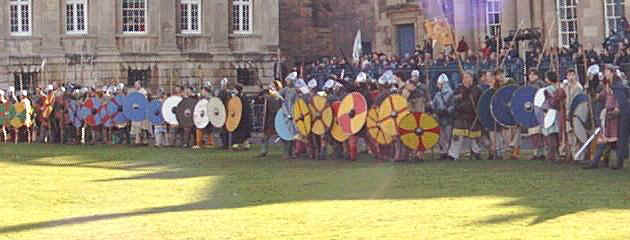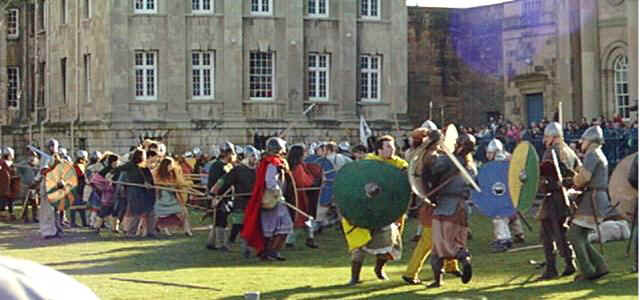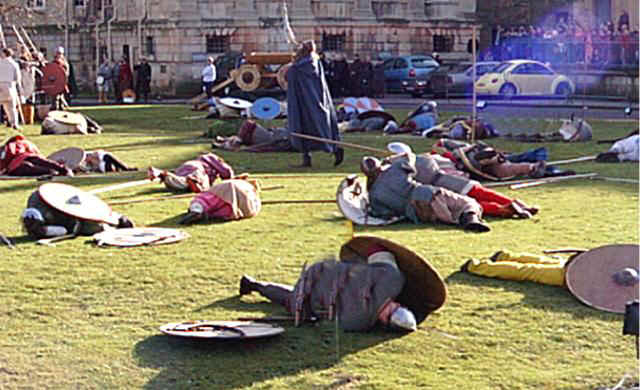
Morcar must have reached Fulford well ahead of the main force of Vikings although Harald would have sent one of his trusted commanders ahead. These scouts would have reported that the way to York had been blocked. The locals had doubtless spent the days before selecting suitable ground to defend the city. Morcar was able to deploy his small army on the ground of his choosing.

Not all of these would have been soldiers. There would have been the cooks, camp followers, foragers, armourers plus the normal compliment of sick, lame and lazy. Perhaps a third of the Viking army remained with the fleet at Riccall. The fighting strength of Norsemen at Fulford was probably about 6,000.
This still gave Harald an impressive numeric superiority. The English army was perhaps as small as 3000 men but it was probably nearer 5000 giving them near parity with the attackers. Each of the Earls could have put 200-500 well trained warriors into the field. These were their personal housecarls. Harald's intentions were well known. Earl Edwin had brought his force from Mercia on the west coast by boat during the summer anticipating this invasion.
Given that there were about 5000 thanes and a population of about 2 million, only 1 in 400 were on the battlefield at Fulford. During World War II over 1 in 10 of the population were under arms.
His boats were moored in the river near Tadcaster. The Anglo-Saxon Chronicle (Worcester MS) says they "gathered from their earldom as great a force as they could get." They could also summon the local fyrd. However, potential conscripts would have had cousins among the invading Viking. The Nordic rule of England established by King Canute had ended just 30 years before. The loyalty to the local subjects could be relied on. They had rebelled against their Earl, Tostig, who was now allied to king Harald.
With his limited force, Morcar needed to find a narrow position where he could stop Harald's progress. He needed a 'choke point' that he could effectively block with the few troops he had available. At Fulford, the ground was marshy and crossed with many ditches. The gap between the river and the marsh at this point was just 600 metres wide with the armies facing each other over less than half this distance.
Across the defender's front ran a stream that drained the marsh and the fen land to the east. This was known as the German Beck and would play a central part in the days fighting. The spot chosen was excellent from a defenders point of view.
The Vikings would need to follow one of the roads from the south although some might follow the longer route along the riverbank from Riccall to York. The position at Fulford would block all southern approaches and there would be no easy route round. Nature had constructed a very good defensive position for the Saxons.
On the attacker's side the ground was marshy while the defender's bank was firm ground. Germany Beck meandered so earl Morcar would have to stretch his troops to cover 300 metres. With about 1000 good troops, the line was 3 or 4 ranks deep with the leaders and experienced warriors in the front. Behind them would be the less well trained and experienced fyrdmen. The chroniclers also tell us that the army came out of the city on the morning of the battle and would have reinforced the 2 flanks as this was the only firm ground.
The defenders could not risk the Vikings going round their line and attacking from behind. The flanks both seemed secure. On the right was the river Ouse. To the left, the ground became too swampy for troops. Today this area is still known as Fordland, a land crossed by numerous rivulet and fords.
Earlier maps call this areas Dam Lands. This was wet land and the Vikings would have at least a half hour detour to find a place to cross the Beck. This was a good place to block Harald's advance. The river on the right and the marshy ground to the left would stop the Viking's bypassing them. In front of the Saxons there was more marshland as well as the beck which formed a trench 3 metres wide and 1 metre deep with naturally steep sides that the Vikings would have to cross in order to attack them. These would provide significant obstacles to the attackers.
The only obvious weakness of the defenders position was some higher ground on the Viking approach route. This would provide a good location for Harald to observe the battle. The lie of the land would also prevent the 2 flanks of the Saxon army observing each other. If either flank gave way the other would be in grave danger but they would only discover this when it was too late. The defenders would also be spared the sight of the flow of Vikings approaching.
A less obvious danger was the marshy land of Fulford Ings behind their position. The track on the York side of the beck was little more than 10 metres wide in places. There was little scope to retreat before they were driven into the swamp. They would have to hold their position along the bank of the Ouse at all costs.

Harald kept his good troops near the riverbank where the land was much firmer. He could either force a way through to York or turn the defender and force them back to the swamp. There is no record what time the battle began. If the Vikings left Ricall at first light the vanguard might have arrived at Fulford about 9 am. It would take the Norse an hour or two to put his army into their initial positions. Harald, with such a numeric superiority, could have launched his attack as soon as these troops were in position. He had experienced commanders who would direct those following.
The battle might have begun mid-morning. There would have been plenty of shouting and psychological warfare from both sides beforehand. According to Hardrad's saga, it was the defenders who struck first which made military sense. They knew they could not resist the full might of the invaders so it made sense to strike before the complete Viking force arrived. The battle seemed to have started well for the Saxons. Morcar's left pushed Harald's troops back along the track and into the marsh but progress was slow as the troops waded through the reeds. This advance, quite literally, bogged down.
The most common weapon was the spear made with a 2 meter long ash shaft and an iron tip. It could be thrown but was normally used to jab. Warriors were trained to hold a heavy shield in one hand and their spear in the other. Most carried and axe which could be used when combat was too close for the spear.
Axes could also be thrown and might have been used to fell a few warriors and open a chink in the shield wall allowing the spears to probe unprotected limbs. These were of single and double headed design. Most were practical tools employed for chopping wood but some had long shafts for use a battle exes. They could be used from behind the shield wall to split the helmets and skulls of the opposition. In open battle it could be swung with devastating effect to scythe down the opposition while the berserk, wielding his axe, remained out of range of sword or spear.
Shields were round, made of wood, often covered with leather and in the centre was an iron boss. The shield would absorb the shock of axe and arrow and could be used to batter and shove the enemy while the spear-carriers arranged behind, stabbed at the opposing side.
Shields were thin, but they could take much of the energy out of an arrow. They would be badly damaged or even shredded during a battle as they took the blows that could have wounded or killed the warrior. Scandinavian archaeologists suggest that every warrior went to battle with at least 2 shields.
The 'front-line' warriors on both sides wore chain mail and helmets for protection but the Anglo-Saxons Fyrd probably had little armour, so they would play a supporting role, leaving the main work to the professionals.
The nobility and housecarls on both sides used swords and would stand in the front rank as befitted their status. The swords were about thirty inches long. These were longer than the short stabbing swords developed by the Romans but also designed for use at close quarters. The metal workers had developed the art of adding edges that could be sharpened for slashing and withstand the blows of battle without shattering the shaft itself.
Bows were used for hunting but were also employed in battle like a sniper weapon or to harass an assembled force. It was an arrow that would kill King Harald at Stamford Bridge. There would also be a great deal of pushing and shoving that would be less exhausting than open battle.
With the front ranks locked together in a shieldwall, it would be up to the spearmen to make a gap in the shield wall or an axe man to split a skull before any progress could be made. In practice, casualties would be light while they were in close contact. The mortal danger came when the battlefield opened out. Then axes and swords could be used lethally. As bodies fell, the ground would become impassable. The battle would have to move on otherwise the bodies of dead and injured would keep the warriors apart. Fulford was about to create the conditions for such massacres.
The loss of the riverbank might not have appeared too serious at first. With the Vikings pressing along the whole line the Anglo-Saxon leaders would have been distracted. The Vikings were now on the firm ground that formed a causeway on the defenders side of the beck. The defenders were now driven back along the ditch and up towards the track where Morkar's men were still getting the better of the Vikings.
There might have been a short respite for the defenders as the Vikings had to fight their way over a smaller beck and then fight up a small hill but the weight of numbers would have ensured their success. Within the space of an hour the defenders had been dislodged from their position along the beck. The situation for the Anglo-Saxons was now becoming perilous although it would have been hard for many of them to perceive it as this was going on behind them and beyond a small hill.
The Vikings who had fought their way from the river bank and along the beck were now behind half of the Saxons near the main track. Other Vikings who arrived later would have found the site crowded and probably moved to the right across the fen land to find a way round. The detour probably took them half an hour. About the time that Harald Hardrada was leading his men up from the river these latecomers were arriving from the other direction.
The Anglo-Saxons were now under attack on 3 sides. Some, possibly including Morcar, were first cut off from the troops defending the Beck and then were forced back down the road to York to make their escape although some sagas say that Morcar perished. More Vikings moved along the high ground watching the defenders at the other side of an opening ravine. From their vantage point they could see that their escape was cut off.
The defenders were being driven towards their doom. Beyond the road, the terrain fell away steeply. Between the Vikings on the high ground and the Vikings driving the defenders backwards was a natural pit. The fate of the Saxons was sealed. They could do little as they fell backwards. Those who were not cut down were crushed. Tales that the beck ran red with Saxon blood are credible.
The battle was over and the way to York was open. Possibly as many as 1000 of the English were casualties. The Chronicler records that the Vikings also suffered heavy losses. "They made a great slaughter too; but there was a good number of the English people slain, and drowned, and put to flight: and the Northmen had possession of the field of battle."
 The city came to terms. The Vikings would not loot the city or otherwise
damage it. King Harald and Earl Tostig went into York to
arrange for hostages, provisions and support before returning to the ships at
Riccall. The
inhabitants recognize Harald as their king and agreed to assist him against King
Harold Godwinson. Harald demanded 100 hostages. They had the customary 5 days to
deliver them. He left content "that all would go southward with them, and
gain this land". The next meeting was scheduled for a hall near Stamford
Bridge.
The city came to terms. The Vikings would not loot the city or otherwise
damage it. King Harald and Earl Tostig went into York to
arrange for hostages, provisions and support before returning to the ships at
Riccall. The
inhabitants recognize Harald as their king and agreed to assist him against King
Harold Godwinson. Harald demanded 100 hostages. They had the customary 5 days to
deliver them. He left content "that all would go southward with them, and
gain this land". The next meeting was scheduled for a hall near Stamford
Bridge.
copyright 2001 Charles Jones Follow the battle sequence